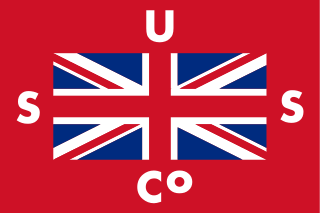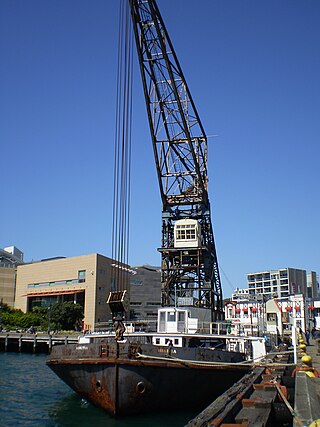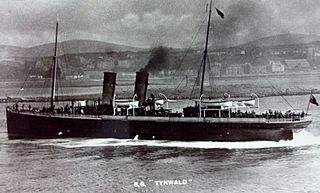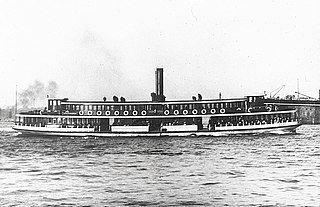
TEV Wahine was a twin-screw, turbo-electric, roll-on/roll-off passenger ferry. Ordered in 1964, the vessel was built by the Fairfield Shipbuilding and Engineering Company, in Govan, Glasgow, Scotland for the Union Steam Ship Company's Wellington-Lyttelton Steamer Express Service in New Zealand.

The Dee Why and Curl Curl, were two identical steam ferries servicing Sydney Harbour's Circular Quay to Manly service. Both commissioned in 1928, they were the largest ferries on Sydney Harbour until the 1938 introduction of the South Steyne.

GMV Aramoana was a roll-on/roll-off train ferry operating across Cook Strait between 1962 and 1983.

Lyttelton Harbour / Whakaraupō is a major inlet on the northwest side of Banks Peninsula, on the coast of Canterbury, New Zealand; the other major inlet is Akaroa Harbour, which enters from the southern side of the peninsula. Whakaraupō enters from the northern coast of the peninsula, heading in a predominantly westerly direction for approximately 15 km (9.3 mi) from its mouth to the aptly-named Head of the Bay near Teddington. The harbour sits in an eroded caldera of the ancient Banks Peninsula Volcano, the steep sides of which form the Port Hills on its northern shore.

Union Steam Ship Company of New Zealand Limited was once the biggest shipping line in the southern hemisphere and New Zealand's largest private-sector employer. It was incorporated by James Mills in Dunedin in 1875 with the backing of a Scottish shipbuilder, Peter Denny. Bought by shipping giant P&O around the time of World War I it was sold in 1972 to an Australasian consortium and closed at the end of the twentieth century.

HMS Defender was a second-class colonial-service torpedo boat built in 1883 for service in New Zealand and abandoned at Lyttelton sometime after 1900. Her remains are today displayed at the Lyttelton Torpedo Boat Museum.

Lyttelton railway station is the northern terminus of the Main South Line, a main trunk railway line from Lyttelton to Invercargill in the South Island of New Zealand. There have been three stations built at Lyttelton, with the most recent of these still being used for railway purposes.

Hikitia is a working self-propelled floating steam crane in Wellington Harbour, New Zealand. She is thought to be the only working steam crane of her type in the world.

SS (RMS) Tynwald (III), No. 95755, was an iron passenger steamer which served with the Isle of Man Steam Packet Company, and was the third vessel in the Company to bear the name.

PS Brighton was a ferry used on the Sydney to Manly run. The biggest Manly ferry at the time and the largest paddle steamer to operate on Sydney Harbour, she was well-appointed and popular with passengers.

Wellington Harbour Board was the body which formerly managed the shipping and commercial affairs of the port of Wellington in New Zealand. It was constituted in 1880 and was disestablished in 1989.

The Herald was an iron paddle steamer imported as frames from the United Kingdom and assembled in 1855 by Richard Johnson in Sydney Harbour, New South Wales, Australia, where she was registered. The Herald is one of the earliest iron paddle wheel steamers built in Australia, where she operated within Sydney Harbour. She was initially used on the fledgling North Shore route between Dawes Point and Blues Point by the newly formed North Shore Steam Company; however, due to not enough traffic to make her financially viable, she often performed tug duties. Eventually the North Shore Steam Company was wound up; the vessel was put up for sale but continued picking up business wherever it was available, operating as a tug, ferry, excursion boat and cargo vessel.
The TEV Rangatira was a roll-on/roll-off vehicle and passenger ferry launched in 1971 for the Union Steam Ship Company of New Zealand. She was the world's last surviving passenger ship with steam-powered turbo-electric transmission.
SS Kate was a wooden carvel screw steamer built in 1883 at Balmain that was twice struck and sunk by Port Jackson & Manly Steamship Company ferries.
Erg was a vessel built and owned by Halifax Steamship Ltd. in 1915. She was used to ferry workers across the harbour to vessels under repair during the Second World War. Erg was sunk in the Halifax Harbour three times and is currently located in the Bedford Basin.

The MV North Head was a ferry operated by the Port Jackson & Manly Steamship Company and its successors on the Manly service from 1913 until 1985.

Mullogh was a ketch rigged steam ship, built in 1855 in Belfast. It sailed to Australia, then to New Zealand. The wreck of Mullogh is now beached on Quail Island.

Kaikai was a "K-class" ferry on Sydney Harbour. Commissioned in 1907, the timber-hulled steamer was built for Sydney Ferries Limited during the boom in cross-harbour ferry travel prior to the 1932 opening of the Sydney Harbour Bridge. At the time of launch, Kaikai was one of Sydney's largest wooden ferries, being the longest and second largest by tonnage. She was a typical example of the "K-class"; a group of double-deck, double-ended, steam-powered screw ferries.

HMS New Zealand's 1913 circumnavigation, between 6 February 1913 and 8 December 1913 was the first by a battleship or battlecruiser of the Dreadnought era. The principal objective of the flag-waving cruise was to thank the people of New Zealand for funding the construction of the battlecruiser HMS New Zealand for the Royal Navy.

TEV Rangatira was a passenger ferry that sailed the Wellington to Lyttelton route between 1931 and 1963. She was the first turbo-electric vessel (TEV) to arrive in Australia or New Zealand waters. During the Christmas season she would also run trips between Wellington and Picton.

















